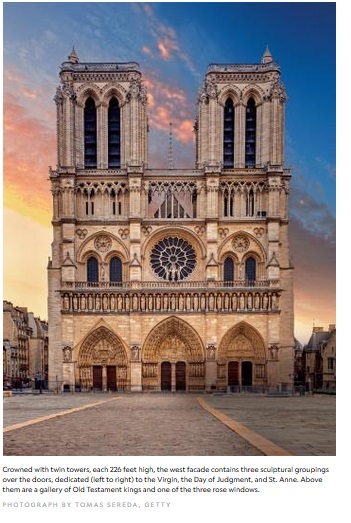Saw this posted on realclearscience https://www
Post# of 333
https://www.nationalgeographic.com/archaeolog...-de-paris/
An 800-year history of Paris's Notre Dame Cathedral

Quote:
1163
The first stone of the cathedral is laid with Pope Alexander III in attendance.
1182
Bishop Maurice de Sully celebrates the first Mass after the high altar has been consecrated.
1240-1345
Incorporating Gothic elements, several different builders guide the cathedral to completion.
1789
French revolutionaries cause major damage to the building, especially the statuary.
1831
Publication of Victor Hugo’s The Hunchback of Notre Dame sparks a campaign to restore the cathedral.
1844
Viollet-le-Duc is appointed to lead a complete restoration of Notre Dame.
and this
https://www.nationalgeographic.com/culture/20...ise-again/
Why history says Notre Dame will rise again
On a spring day in 1163, the first foundation stone for the building that would become the cathedral of Notre Dame was set into the soil of Paris’ Île de la Cité, on a patch of land where an earlier Christian basilica—and centuries before that, a Roman temple—stood. Over the centuries, Notre Dame rose as the spiritual and civic center of Paris, then became a target of Hugenot vandals in the 16th century, rampaging revolutionaries in the 18th century, and Nazi occupiers in the 20th century. During its 850 years, the cathedral was a target of adoration and revolt, damage and reconstruction, and yet the 12th-century foundation remained firmly planted on the island in the Seine.
Now, on a mild spring evening in the 21st century, as the cathedral of Notre Dame burned, a human chain of Parisian police and city officials hastily evacuated some of its most important portable treasures: a crown of thorns that, according to Christian tradition, graced the head of a crucified Christ, and the tunic worn by Louis IX when he presented the relic to Notre Dame around 1238, a little more than 70 years after construction on the cathedral began. Out came more items from the Treasury—gold chalices, silver ewers, liturgical books—gifted to the church after its earlier contents were looted in 1789 during the French Revolution. (Discover the 800-year history of Notre Dame.)
Then there were the objects impossible to move: the enormous bells in the north and south towers that tolled at some of the most significant moments in French history; the Great Organ, with 8,000 pipes crafted across several centuries that filled the cathedral with music; the Rose Windows, enormous sparkling wheels of medieval stained glass that illuminated its aisles. At the time of writing, the damage to these features is unknown
“The building itself is the treasure, and all of the other things are just details of this great project in the Middle Ages to make this really sublime structure that can hold all of this art,” says Cohen. “It was a kind of utopian vision for people in the Middle Ages, and they really wanted it to last forever.”
“A cathedral was also a source of civic pride, whether or not you considered yourself great Catholic,” adds Nancy Bisaha, professor of history and director of medieval and renaissance studies at Vassar College. “It was something that drew people to your town. It was something that that put you on the map, so in that sense, it's something that you don't even have to be a member of the faith to take pride in being part of your town part, of what you were about.”
And since Notre Dame is such a seminal landmark to Parisians and all French citizens, rebuilding and restoring the cathedral will be complicated, Cohen notes. The medieval foundations still stand, but should the spire be rebuilt in its 19th-century Gothic revival style, for instance, or in its earlier medieval version, or as a product of 2019 that sits in harmony with the earlier structures?
 (0)
(0) (0)
(0)